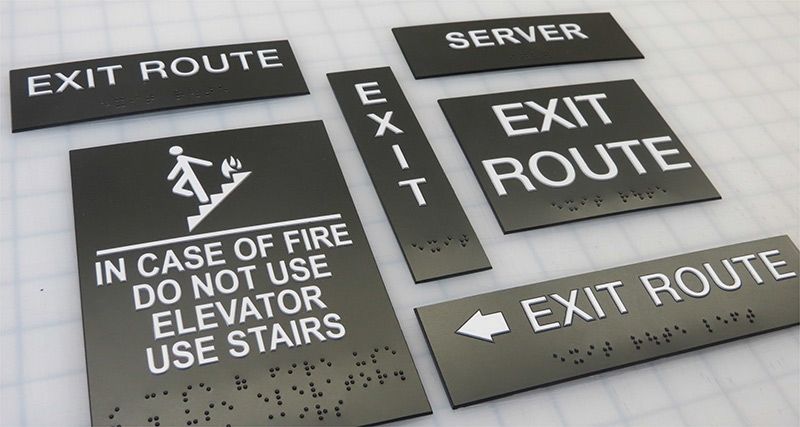Exactly How ADA Signs Enhance Access for Everyone
Exactly How ADA Signs Enhance Access for Everyone
Blog Article
Checking Out the Trick Features of ADA Indications for Boosted Access
In the realm of access, ADA indicators serve as quiet yet effective allies, ensuring that spaces are accessible and comprehensive for people with impairments. By incorporating Braille and tactile components, these indicators damage barriers for the aesthetically impaired, while high-contrast shade plans and legible fonts cater to varied visual requirements.
Relevance of ADA Conformity
Ensuring conformity with the Americans with Disabilities Act (ADA) is essential for fostering inclusivity and equal accessibility in public areas and workplaces. The ADA, established in 1990, mandates that all public facilities, employers, and transport solutions suit people with specials needs, guaranteeing they enjoy the exact same civil liberties and possibilities as others. Compliance with ADA standards not just meets lawful commitments but additionally improves a company's credibility by showing its commitment to variety and inclusivity.
One of the key facets of ADA compliance is the application of easily accessible signs. ADA indicators are created to guarantee that people with handicaps can quickly navigate via buildings and areas. These indications have to comply with certain guidelines regarding size, font, color comparison, and positioning to guarantee visibility and readability for all. Correctly executed ADA signs assists get rid of barriers that people with handicaps often run into, consequently advertising their independence and self-confidence (ADA Signs).
Additionally, sticking to ADA guidelines can minimize the danger of lawful consequences and possible fines. Organizations that fall short to abide by ADA guidelines may encounter penalties or legal actions, which can be both harmful and monetarily challenging to their public picture. Thus, ADA conformity is important to cultivating a fair environment for everyone.
Braille and Tactile Components
The incorporation of Braille and tactile components into ADA signs personifies the concepts of access and inclusivity. These functions are vital for people that are aesthetically damaged or blind, allowing them to browse public areas with better self-reliance and self-confidence. Braille, a tactile writing system, is vital in giving composed info in a layout that can be conveniently regarded with touch. It is normally placed beneath the corresponding text on signage to ensure that individuals can access the info without visual aid.
Responsive aspects expand past Braille and include increased personalities and signs. These components are designed to be noticeable by touch, permitting individuals to identify room numbers, washrooms, leaves, and various other critical locations. The ADA establishes particular guidelines concerning the size, spacing, and positioning of these tactile aspects to maximize readability and ensure consistency across various atmospheres.

High-Contrast Color Design
High-contrast color systems play a critical function in enhancing the exposure and readability of ADA signage for people with visual problems. These systems are vital as they maximize the distinction in light reflectance in between message and background, making sure that indications are easily noticeable, also from a distance. The Americans with Disabilities Act (ADA) mandates using particular color contrasts to suit those with minimal vision, making it a critical facet of compliance.
The effectiveness of high-contrast shades depends on their capability to attract attention in numerous lighting problems, consisting of poorly lit environments and areas with glare. Usually, dark text on a light background or light text on a dark history is used to attain optimal contrast. Black text on a yellow or white background supplies a plain visual difference that assists in quick acknowledgment and comprehension.

Legible Fonts and Text Size
When thinking about the layout of ADA signage, the option of understandable font styles and ideal message size can not be overemphasized. The Americans with Disabilities Act (ADA) mandates that see this fonts have to be sans-serif and not italic, oblique, script, extremely decorative, or of unusual kind.
According to ADA guidelines, the minimal message elevation should be 5/8 inch, and it ought to enhance proportionally with watching distance. Uniformity in text dimension contributes to a natural aesthetic experience, aiding individuals in browsing environments efficiently.
Additionally, spacing in between lines and letters is important to readability. Ample spacing avoids characters from appearing crowded, boosting readability. By adhering to these requirements, developers can substantially improve access, making sure that signs offers its intended purpose for all individuals, no matter their visual capabilities.
Reliable Placement Strategies
Strategic positioning of ADA signs is necessary for maximizing accessibility and making certain compliance with lawful standards. Effectively positioned indicators assist people with handicaps efficiently, facilitating navigating in public rooms. Trick considerations consist of visibility, elevation, and distance. ADA standards specify that signs must be installed at a height in between 48 to 60 inches from the ground to guarantee they are within the line of view for both standing and seated individuals. This conventional height variety is vital for inclusivity, making it possible for wheelchair users and individuals of differing elevations to access info easily.
In addition, indications should be put adjacent to the latch side of doors to permit very easy identification before entry. This positioning helps people situate rooms and rooms without obstruction. In cases where there is no door, indicators need to be located on the nearby surrounding wall. Uniformity in indication placement throughout a center enhances predictability, minimizing complication and improving total customer experience.

Final Thought
ADA indicators play an important function in advertising access by integrating functions that address the requirements of people with handicaps. These elements jointly cultivate a comprehensive environment, emphasizing the relevance of ADA conformity in ensuring equivalent gain access to for all.
In the world of availability, ADA indications serve as silent yet powerful allies, ensuring that rooms are inclusive and accessible for people with disabilities. The ADA, enacted in 1990, mandates that all public centers, employers, and transport solutions suit individuals with impairments, ensuring they appreciate the very same civil liberties and opportunities as others. ADA Signs. ADA signs are designed to guarantee that individuals with specials needs can conveniently browse through buildings and areas. ADA standards stipulate that indicators need to be mounted see this site at an elevation in between 48 to 60 inches from the ground to guarantee they are within the line of sight for both standing and seated individuals.ADA signs play a crucial function in advertising ease of access by integrating attributes that address the demands of individuals with disabilities
Report this page